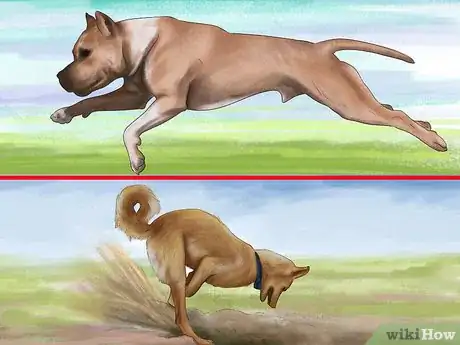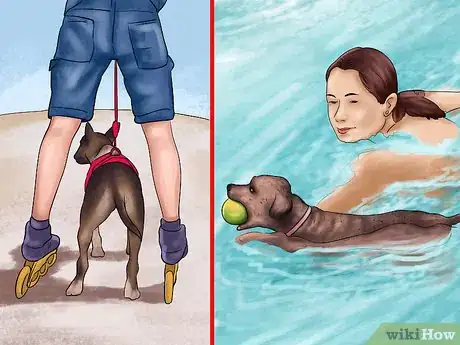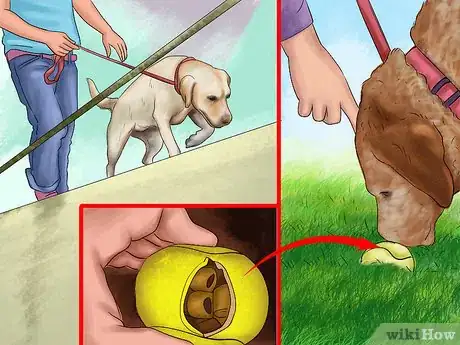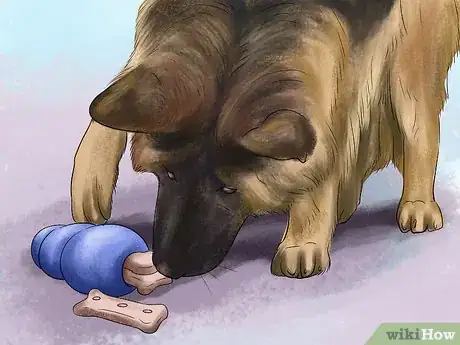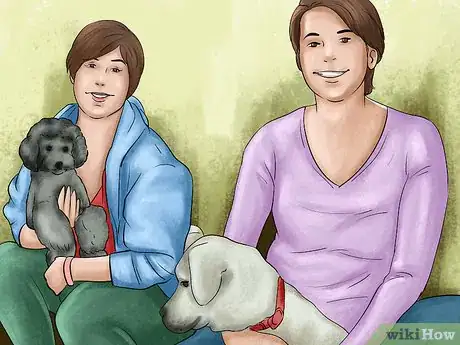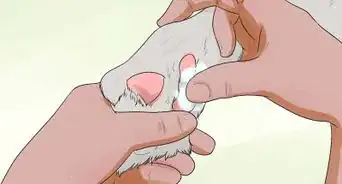This article was co-authored by Deanne Pawlisch, CVT, MA. Deanne Pawlisch is a Certified Veterinary Technician, who does corporate training for veterinary practices and has taught at the NAVTA-approved Veterinary Assistant Program at the Harper College in Illinois and in 2011 was elected to the board of the Veterinary Emergency and Critical Care Foundation. Deanne has been a Board Member of the Veterinary Emergency and Critical Care Foundation in San Antonio, Texas since 2011. She holds a BS in Anthropology from Loyola University and an MA in Anthropology from Northern Illinois University.
There are 21 references cited in this article, which can be found at the bottom of the page.
This article has been viewed 15,152 times.
Activity is key to any dog’s health and happiness. Many breeds instinctively “work” through physical activity.[1] But some breeds such as shepherds, herding dogs, terriers, and retrievers have a lot more energy than their counterparts including bulldogs.[2] If you have a high energy dog, it’s important to give it enough activity to prevent boredom, frustration, and destructive behaviors. It can also help maintain your high energy breed’s health.[3] You can live with a high energy dog by giving it enough exercise daily, incorporating it into daily tasks, and keeping it occupied.
Steps
Recognizing Activity Needs for Your High Energy Dog
-
1Identify high energy breeds. It’s important to know if your dog is a high energy breed. This can ensure that you get it enough activity so that it doesn’t get bored or exhibit destructive behaviors. Most dogs in the hunting, working, or herding groups are high energy. These groups include retrievers, hounds, collies, spaniels, pointers, terriers, and shepherds. Some specific dog breeds that are high energy include:[4]
- Alaskan Malamute
- Bernese Mountain Dog
- Norwich Terrier
- Shetland Sheepdog
- Weimaraner
- Parson Russell Terrier
-
2Figure out your dog’s exercise needs. Simply taking your high energy dog for one or two short walks isn’t enough activity, nor is letting it loose in the backyard. High energy dogs need more exercise than low energy breeds. In general, they will need at least 30 minutes of vigorous exercise every day as well 1-2 hours of additional activity. Some great ways to meet your high energy dog’s both indoors and outdoors include:[5]
- Walking
- Running
- Swimming
- Climbing and/or running up stairs
- Throwing toys
- Enjoying time in a fenced-in yard
- Obstacle courses[6]
Advertisement -
3Watch for warning signs. High energy dogs are easily bored if they have nothing to do and destroy furniture, pillows, clothing or other household items as a result.[7] Watching your high energy dog’s behavior can signal if it needs more exercise or activity.[8] Some signs your dog may have energy to burn include:
- Barking or whining
- Digging
- Jumping
- Restlessness
- Chewing, nipping, or biting
- Scratching[9]
Incorporating Activity During the Day
-
1Establish a regular activity schedule. High energy dogs need regular exercise as a result of their evolution. Your breed may require as many as 2 ½ hours of activity every day.[10] This may be a lot of time if you are very busy. Setting a daily activity schedule can keep your high energy dog healthy and happy. The routine helps your dog anticipate it and may minimize unwanted behaviors.[11]
- Establish a specific time every day for 30 minutes of vigorous activity with your dog. For example, set aside 30 minutes every morning to run. If you don’t run, let your dog run in an enclosed yard or dog park for 30 minutes. You could also play fetch or blow bubbles specifically designed for dogs to chase.[12]
- Incorporate a brisk walk of about an hour every day, too. Break this into two 30-minute walks if need be.
- Adjust your dog’s exercise routine as necessary. For example, if you have an appointment and get home early, use the extra time to engage your high energy dog.
-
2Get activity you and your dog enjoy. Just like people, every dog has a distinct personality. Your dog may run or play harder in certain place or with specific activities. Take at least one day to do something with your dog that you both enjoy but can’t get to daily. You could do any of the following “doggy and me” activities:[13]
-
3Have fun indoors. If it is extremely cold or hot outside, it’s safer to keep your dog inside except for potty breaks. You can still give your high energy dog plenty of activity even if you are indoors.[17] This can also be a great way to give your high energy dog activity if you are worn out or physically unwell. Doing any of the following can ensure your high energy gets enough activity and exercise so that it doesn’t get bored:[18]
-
4Create a safe outside space. A backyard is a great space to give your dog some activity. It’s not sufficient as a form of exercise, but can help burn off extra energy if you are worn out or otherwise unwell. Make sure to always supervise your dog in a fenced-in yard space.
- Turn outdoor time into exercise time, even if you are unwell or worn out. You can easily do this by sitting outside or in a doorway and throwing your dog a ball, Frisbee, or other item to retrieve for you. Incorporate some games of tug while you’re watching your dog for added activity.[22]
- Consider a dog park as an alternative to a yard space. This can help your dog get exercise and activity that burns energy—and boredom.
-
5Make your dog work for its meal. Your dog may be hungry when it comes in from outside or after an indoor activity. Feeding your dog by using smart toys such as Kongs, Buster Cubes, Squirrel Dudes, and Tug-a-Jugs can provide vital activity and mental stimulation that requires little effort on your part.
- Consider giving your dog some of its regular food when you get home so it’s not starving. Then put the rest into a smart toy.
- Recognize that this is a great way to keep your dog busy when you are not home, feeling unwell, or unable to provide more activity because of external factors.
-
6Ask family and friends for help. It may be difficult at times to live with your high energy dog. This is true if you are worn out, physically unwell, or stressed out. Enlist the help of family members or friends with your dog. Many people are more than happy to help out with a cute pet. This can give you a needed break and provide your dog with the necessary activity to burn its energy and stay content.
- Consider asking friends who have children to give you a hand. Kids often love dogs and have similar amounts of energy to run around and play games.
Keeping Your Dog Busy While You’re Away
-
1Create a “doggy den.” Dogs are social animals that live in packs in the wild. Because of this, high energy dogs need more stimulation and are more prone to separation anxiety. This can be especially true if you have to leave your dog for 8-10 hours a day. Separation anxiety can lead to inactivity as well as cause boredom and destructive behaviors. Making a safe space that mimics a den can ensure your high energy dog gets enough activity and doesn’t develop separation anxiety.[23]
- Put the dog in a dog-proof room or its crate. Make it comfortable with familiar toys, food and water, and other things to keep it busy such as chew sticks.[24]
- Leave a piece of your recently worn clothing to provide your dog extra comfort.
-
2Place toys in the den. Your high energy dog will still need activity even in a doggy den. Providing it toys can help your dog get exercise and entertainment until you get home. Consider putting the following toys in your dog’s space:[25]
- Hard rubber toys for chewing and carrying around
- Rope toys
- Balls
- “Busy box” toys with hiding places for snacks.
- Soft, stuffed and/or squeaky toys
- Chew toys[26]
-
3Try doggy daycare or a walker. Your high energy dog may have more activity needs than you can accommodate. If you need to leave for longer periods of time, consider putting your dog in day care. You can also employ a professional dog walker. Both can provide attention and activity when you can’t. Your dog should always return home happy and worn out from day care or time with a dog walker.[27]
- Save the contact information for a couple of dependable dog walkers. They can help you in a pinch or if one is on vacation or otherwise unavailable.
References
- ↑ http://pets.webmd.com/dogs/guide/exercise-dogs
- ↑ http://dogtime.com/dog-breeds/characteristics/energy-level
- ↑ http://www.petmd.com/dog/wellness/evr_dg_exercising_with_your_dog101
- ↑ http://dogtime.com/dog-breeds/characteristics/energy-level
- ↑ http://dogtime.com/dog-health/general/12204-20-dogs-that-need-lots-of-exercise
- ↑ https://www.cesarsway.com/dog-training/toys-and-play/ways-to-exercise-your-dog-indoors
- ↑ http://www.canidae.com/blog/2013/10/telltale-signs-your-dog-needs-more-exercise/
- ↑ https://www.paws.org/library/dogs/behavior/high-energy-dogs/
- ↑ http://www.canidae.com/blog/2013/10/telltale-signs-your-dog-needs-more-exercise/
- ↑ https://www.paws.org/library/dogs/behavior/high-energy-dogs/
- ↑ http://dogtime.com/dog-health/fitness/49-exercise-needs
- ↑ https://www.paws.org/library/dogs/behavior/high-energy-dogs/
- ↑ http://pets.webmd.com/dogs/guide/exercise-dogs?page=3
- ↑ https://www.paws.org/library/dogs/behavior/high-energy-dogs/
- ↑ http://pets.webmd.com/dogs/guide/exercise-dogs?page=5
- ↑ http://pets.webmd.com/dogs/guide/exercise-dogs?page=6
- ↑ http://dogtime.com/dog-health/fitness/49-exercise-needs
- ↑ https://www.cesarsway.com/dog-training/toys-and-play/ways-to-exercise-your-dog-indoors
- ↑ https://www.paws.org/library/dogs/behavior/high-energy-dogs/
- ↑ http://www.dogster.com/lifestyle/dog-training-exercise-behavior-tips-high-energy
- ↑ http://pets.webmd.com/dogs/guide/exercise-dogs?page=6
- ↑ http://www.whole-dog-journal.com/issues/16_6/features/dog-games-physically-impared_20758-1.html
- ↑ https://www.paws.org/library/dogs/behavior/high-energy-dogs/
- ↑ http://www.humanesociety.org/animals/dogs/tips/separation_anxiety.html
- ↑ http://www.caninejournal.com/why-dogs-eat-grass/
- ↑ https://www.paws.org/library/dogs/behavior/high-energy-dogs/
- ↑ http://dogtime.com/dog-health/fitness/49-exercise-needs
About This Article
If you’re going to live with a high energy dog, make sure you give it at least 30 minutes of vigorous exercise and 1 to 2 hours of extra physical activity every day. For example, you can walk it, let it go swimming, give it time to play in a fenced-in yard, and even take it to a dog obstacle course. Even if the weather is too cold or too hot to exercise outside, you can have fun with your dog indoors by playing fetch and keep away. You may find it helpful to set up an exercise routine where your dog has a daily schedule of activities, like a 30-minute run every morning and an hour-long brisk walk in the afternoon. For more tips from our Veterinary co-author, including how to make sure your high energy dog gets enough stimulation when you’re away, keep reading!


